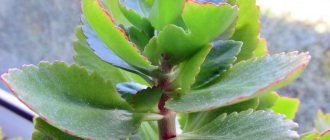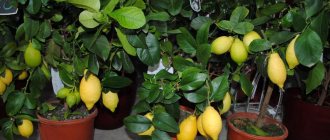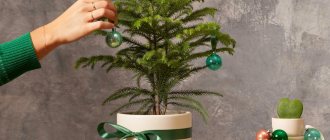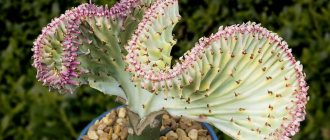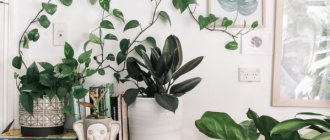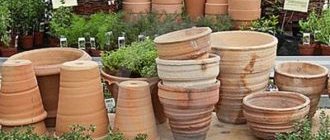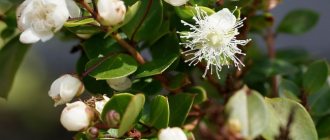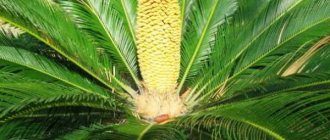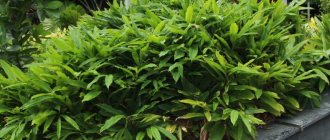Today, perhaps, there is not a single office, room or home that does not have at least one flowerpot. On the contrary, flower arrangements decorate spacious reception rooms, bedrooms, living rooms and hallways of residential buildings. It is impossible to imagine the terraces of country houses and cottages without hanging flowerpots and exposed flowerpots. Living compositions successfully decorate human habitats. It is a mistaken belief that only flowering plants can decorate the interior. Evergreen conifers can also add charm, comfort, contrast and beauty to a room. Despite the fact that these woody shrubs do not produce flower buds at all, they are beautiful and will perfectly complement a flower arrangement of flowering plants.
Many flower growers independently propagate the conifers they like, having initially bought a seedling at a flower shop. When purchasing an evergreen coniferous plant, it is necessary to take into account some of the features and characteristics of conifers. Recommendations from florists on choosing a high-quality seedling capable of reproducing in the future will also not be superfluous.
Kinds
Houseplants belonging to this group have many varieties. As a rule, they are most often grown in gardens and park areas. The thing is that the homeland of these evergreen trees and shrubs is a subtropical and temperate climate. It would seem that the dry air of our premises is not the most favorable microclimate for them.
In fact, this is the case, but who said that you cannot create optimal growing conditions for these plants yourself? In addition, you can choose from this whole variety of conifers truly unique and very beautiful specimens:
- araucaria. If we talk about a full-fledged tree growing in natural conditions, it can reach a height of up to 60 m. Indoor plants, of course, are quite miniature, but even indoors you can independently grow a stunning indoor tree with tetrahedral, soft-touch needles. It is advisable to place the araucaria away from a window where bright light comes from, since the plant does not like direct rays. Choose a dimly lit corridor;
- cypress. This bright green coniferous shrub is the highlight of any plant island. It grows to an impressive size, as for a house plant. Cypress needles are distinguished by the presence of a golden hue. A notable feature of this shrub is the fact that changes in growing and maintenance conditions do not have a very beneficial effect on the plant. Even if you move a flowerpot with cypress to another place or simply move or unfold the flowerpot, this conifer may react painfully to such measures;
- cryptomeria. A coniferous tree of amazing beauty that can reach a height of up to 2 m. The shape of the crown can be formed independently, in general it looks quite neat, and branches with rich green needles hang from it. Over time it becomes yellowish. Another key characteristic is the presence of small cones that do not fall off the tree for a long time, decorating it. As for care, there are no particularly complicated rules, but you must know the key steps for caring for cryptomeria if you want your plant to successfully take root indoors;
- deodar. This plant is also not included in the group of the most fastidious evergreen conifers. Nevertheless, it is also undesirable to forget about it for a long time. For example, experts very often recommend alternating temperature conditions in winter, that is, moving a flowerpot from a warm place to a cool one. An indoor tree should spend most of its time in a cool, shaded room that receives diffused light;
- juniper. Another popular coniferous tree, which can often be found in private flower collections. The plant loves sunlight, but not direct rays, and also reacts negatively to sudden changes in temperature;
- thuja (western or folded). In fact, there are quite a few varieties of thuja, but these two are considered frequent guests in the home flower garden. These types differ in the shape of the crown, the richness of the shade of the needles, as well as its softness. If you consider yourself a connoisseur of exquisite indoor plants, you should consider finally getting a thuja.
There are many attractive representatives of evergreen conifers. The main thing is to decide on the specimen you like and carefully study the basic recommendations for caring for it.
Features of a successful purchase
Initially, it should be noted that coniferous plants do not immediately signal their problems. If the blooming bud of an indoor flower immediately withers when the usual conditions of maintenance are violated, then conifers retain their natural color for a very long time, and when the death of the plant is inevitable, it changes its beautiful green color to dark gray. And then resuscitation is simply useless.
So, we offer basic rules and secrets that you should definitely pay attention to when buying conifers.
- When choosing a proposed seedling, feel the plant. The branches should be elastic, and the needles should be stiff and stick well to the branch. Otherwise, the proposed plant slowly dies and is unlikely to take root in a new place.
- If possible, inspect the roots. If white or slightly yellowish roots are visible through the pot, plump and juicy, then the plant is absolutely healthy and can be easily purchased.
- Take time to study the needles on a small seedling - they should be strong, characteristic of the plant variety, color shade and shape.
- Inspect the soil mixture in which the proposed ephedra grows. If the soil is loose and moist, then the plant is “healthy”; if the soil is dried out in one large lump, then “resuscitation” in the form of watering will no longer help this plant.
- Examine the pot in which the ephedra is offered in the store. Plants do not like to be disturbed, react poorly to handling and may even die if repeatedly moved from one pot to another. Therefore, it is better to immediately choose a plant in a suitable flowerpot, in your opinion, and not replant it at home.
And, of course, you should not remove the store-bought substrate during the necessary transshipment. Conifers are very picky about propagation and they are obviously engaged in this process not by beginners, but by professionals, which means that the plant will serve as a decoration for your home for many years.
Tips for caring for indoor conifers
Different indoor coniferous plants in pots require certain care, but there are general recommendations on how to look after your green pets:
- For trees to feel good, they need moist air. Therefore, in summer they are sprayed every day, and in winter - less often. From time to time the needles are moistened;
- 6-10 degrees Celsius is the optimal temperature for “green residents”. Therefore, it is difficult to create such conditions for them in an apartment;
- These representatives of the flora do not require good lighting;
- Conifers will not be suitable for soil for flowers or seedlings, but nutritious and light soil will be in great demand by them. Its composition should include several parts - coarse sand, soil based on pine needles (or heather), and leaf. Making such a mixture will not be easy, so it is better to buy a ready-made special substrate;
- The trees are sensitive to wet soil, so they are watered daily in the summer season. In winter, watering is not carried out every day, but drying out of the soil layer is unacceptable, and also try to avoid excess water.
Conifers in compositions and individually
Conifers in pots on the balcony and terrace look great individually or in the company of other plants . Even a small group of coniferous plants looks quite impressive. You can combine and mix different shapes - columnar, spherical and creeping. In addition to varieties with green needles, there are also silver, golden, yellow and blue-gray ones. Thanks to this variety, you can create multi-color compositions.
On a large terrace, you can create a hedge in containers from columnar thujas or junipers planted in tubs or long wooden boxes. In large tubs and wide boxes you can create a real small alpine garden on the balcony. You should choose varieties and species that grow fairly slowly, and supplement the entire composition with perennials. All it takes is imagination and desire, followed by careful care.
The choice of coniferous plants for a balcony or terrace is huge - everyone will find something for themselves. Varieties with a variety of needle colors can be combined with other conifers or perennials and small evergreen or leafy shrubs. Conifers look great in combination with seasonal flowering plants . It is worth remembering that taller specimens should be planted at the back of the pot, and with low shoots - at the front. Due to different needs for water and fertilizers, they should be planted in a separate container, and also watered and fertilized separately.
Substrate selection
The composition of the soil for growing coniferous plants at home depends on several factors: temperature, air humidity, light and your own watering style.
A lot depends on experience here - undoubtedly, after several years of practice, you will be able to select the final composition of the soil mixture that is ideal for your conditions.
The basic composition for conifers includes turf soil, leaf soil, peat soil and sand in a ratio of 1:2:1:1. You can supplement this mixture with 0.5 parts of coniferous soil.
It’s even easier to purchase a special “name” substrate that will suit your plant specifically. You can purchase it at any specialized store.
How to grow the coniferous tree Araucaria varifolia at home
Araucaria variegated in the photo
Variegated araucaria (tall) often comes to us as an import from Scandinavia.
Its homeland is Brazil, the islands of New Caledonia, where entire thickets of various types of araucaria form light, transparent forests. Araucaria was brought to Europe after the expedition of the legendary Captain Cook.
Watering frequency
In the summer, especially if it is very hot, conifers need generous watering. Water with settled water at room temperature (or even cooler if we are talking about plants at rest). At the same time, you need to monitor the condition of the earthen clod; you must not allow it to become waterlogged or dry out - both are detrimental to plants of this class. In the fall, watering is reduced little by little, as they say “drop by drop,” to moderate. During the period when the air temperature outside the window has already dropped and the room is not yet heated, coniferous trees need to be watered especially carefully, especially in rainy weather. The fact is that the dampness of an unheated room itself leads to slower drying of the soil. Precipitation increases air humidity, and thereby “slows down” the drying process even more, so there is a risk of simply flooding the plant.
In winter, you need to moisturize moderately, but there are some nuances here. On the one hand, due to the operation of central heating, the air humidity in the room decreases, and this leads to rapid evaporation of water. But on the other hand, when the pot is on the windowsill, the soil in it is often cold, especially if there are cracks in the window frames and a stream of cold air blows directly onto the pot. In such soil, moisture is much less absorbed by the roots. Therefore, if there are cracks, you need to carefully seal them so that you prevent excessive cooling of the pot.
In spring, watering should be increased again. Throughout the year, it is very important to regularly spray the crown with settled water heated to a temperature of +25°C. It is good to carry out this procedure 2 times a day, morning and evening.
Which pine trees are suitable for growing in a pot?
Pine is one of the most familiar coniferous species for residents of temperate latitudes, capable of invigorating and giving strength with its appearance and aroma. Evergreens help relieve depression during long, cold, dark winters. But the main problem is that the main green inhabitants of the rooms come from tropical latitudes, where it is hot and the sun shines all year round. On the other hand, pine is a northern tree, and its more southern varieties are also used when there are significant seasonal temperature changes. Therefore, to grow pine in a pot, it is better to provide a balcony, terrace or veranda.
In addition, Scots pine and many other species are large trees, reaching a height of many tens of meters. For storage in pots, its dwarf varieties are best suited, which even in adulthood rarely exceed 1 m in height; some bushy or creeping species are also suitable. In addition to their small size, they also have an often slow growth rate, making them ideal for potted crops. Because replanting is a very traumatic procedure for any coniferous tree.
So, if the task is to grow a pine tree in a pot, then you should choose from subtropical species of dwarf varieties.
In the modern assortment, the choice of such plants is quite large. Below are the most popular varieties of pine, more or less suitable for growing in pots:
- Bosnian (variety Smidtii) is a dwarf spherical variety.
- Mountain (variety Pumilio) is an elongated shrub of low height.
- Mountain (cultivar WinterGold) is a miniature ephedra variety whose needles change color depending on the season from light green to golden yellow.
- Weymutova (Radiata variety) is a slow-growing dwarf variety, reaching 80 cm in height only after 10 years.
- Prickly - a variety that grows as a bush, adding no more than 10 cm in height per year.
A comment! Experts in some of these varieties can grow mature pine trees in bonsai style at home. But this business is very complex and requires a truly professional approach.
How to care for coniferous plants in winter
- A green pet feels most comfortable on a cold window on the north-eastern or northern side, on a glassed-in veranda or loggia. The temperature level should not be below zero, and freezing of the soil must not be allowed;
- These representatives of the flora are very resistant to low temperatures, but in a small pot you need to avoid freezing the roots, because they can die immediately;
- In winter, trees are in a calm state, so they do not require fertilizing with growth stimulants. They begin to be held from the beginning of March. In the summer, you can take the “green resident” with you to the dacha and plant it directly in a pot in open ground in a shaded corner so that the tree grows in cool soil, which will allow it to “steam” in the hot air;
- Cover the substrate with a cloth to prevent earthworms and insects from getting into the pot. At the beginning of September, it is dug up, washed and transferred to the apartment.
Deodar
This evergreen plant loves bright, indirect sunlight. You can keep it in a warm room in winter for about a week, after which it is necessary to provide cooler conditions (from 0 to 10 ° C). With the onset of spring, before the first frost begins, it is recommended to take the cedar out into the open air, into a sunny corner.
It is necessary to periodically spray and water the plant regularly. Replanting does not have a very good effect on cedar, so immediately choose a spacious tub for it and replant it only when it grows too large for your apartment.
Replanting a coniferous plant
- From a small shipping container, a store-bought tree is transplanted into a ceramic, plastic or clay pot with a diameter of no more than 10-15 cm, with drainage holes;
- These trees are difficult to tolerate “relocation”, so it is done once every 2-3 years. Replanting indoor coniferous plants is carried out in such a way that the earthen ball is not disturbed and the roots are not damaged;
- Expanded clay drainage is placed in the pot, activated charcoal or charcoal is added for disinfection purposes, and a little substrate is added. The “green friend” is carefully removed from the container along with the soil, preventing the loose soil from falling off. The earthen lump is held with one hand, the new substrate is poured with the other hand;
- The specimen is planted at the same depth as before.
Coniferous plants for an apartment are very beautiful and aesthetically attractive. Thanks to them, there will always be fresh air in your home. Despite the fact that plants require careful care, your efforts will be well worth it.
How to propagate the coniferous houseplant Araucaria excelsa at home (with photo)
Araucaria excelsa in the photo
Araucaria excelsa (noble) is native to South Africa and Australia. A beautiful tree up to 1.5-2 m in height, with a regular tiered arrangement of whorled branches. The needles of this plant are linear-subulate, imbricated. In the Compact form, it is a light green, bright color. On the contrary, the “Bidwilli” form has dark needles with a bluish tint.
Wintering
Winter is a real test for domestic pines, spruces, thujas, cypresses and other conifers. It is improper maintenance in winter that is the main, and often the only, reason for their death. The most difficult thing is to ensure the desired temperature - in winter it should be in the range of +6–12°C, which is difficult to achieve in room conditions.
The most problems with wintering coniferous plants arise for those who do not have a balcony or loggia. It’s good if the window blocks are of an old design and there is enough space between the frames to place a plant there.
If the coniferous plant is simply kept on the windowsill, it must be insulated as much as possible from heat (for example, using a light frame covered with polyethylene, or an ordinary cardboard box). But if we take into account that there is usually a central heating radiator under the window sill, and the heating here is - let's face it - good, such conditions cannot, alas, be called acceptable for coniferous plants.
But the presence of a well-insulated loggia greatly simplifies this task. The only drawback is difficult ventilation, so you need to think in advance about ways to get fresh air (for example, a small window).
To maintain the required temperature in the loggia, you can use an electric heater connected to a temperature sensor (in this case, when the temperature drops, the heater will automatically turn on, and when the air temperature warms up to +10°C, it will turn off).
You can try to heat the loggia not with electrical appliances, but by pumping warm air from the room. In this case, it will be necessary to make special holes through which, in fact, air flows will flow. The operation of the blower fan can also be controlled using a temperature sensor located on the loggia. If the plant pot is on the floor, the soil may freeze. To heat it, it is good to use a radiant infrared heater.
In case of severe frosts, when it is impossible to maintain the required temperature on the loggia, the pot with the plant is transferred indoors to the coolest place. After a few weeks, the plant will awaken and begin to grow - then it will need additional lighting (how to organize it is described in detail in the article “Basics of proper lighting for indoor plants”).
Araucaria
Photo: indoor araucaria
Araucaria or Norfolk pine is a slow-growing tree characterized by a pyramidal skeletal shape with dark green needle-like leaves. In nature in its homeland, araucaria reaches 60 meters, but its indoor counterparts, as a rule, do not exceed one and a half. But even in such a miniature state, it is quite possible to grow a specimen with attractive tetrahedral needles.
Photo: Araucaria needles
It is necessary to place the container with araucaria away from the window. The tree does not like direct sunlight, preferring the shade of a city apartment. Otherwise, it is considered the only unpretentious conifer among indoor plants, perfectly adapting to growing and wintering indoors.
Errors during cultivation
Growing coniferous indoor plants is a labor-intensive task, but if proper conditions are created, they will delight you with their beauty and magnificent coniferous aroma for many years. Here are the most common mistakes when growing indoor coniferous plants:
- lack of regular spraying of the crown, especially in the hot summer;
- non-compliance with a certain temperature regime;
- application of fertilizing in winter;
- using pots of insufficient size;
- excessive movement of a pot of ephedra from place to place.
Selection of conifers for pots on the balcony and terrace
The variety of needle colors and shapes can be dizzying. Choosing suitable conifers for a balcony and terrace can be quite a difficult task , since it is very difficult to assess what will grow from a small seedling in a few years. Balconies often have limited height, so views will be best experienced there if they are not large in size. Only miniature, slow-growing and creeping varieties and varieties are suitable for flower pots on a balcony or terrace. Dwarf species are available in almost any garden center, so even owners of a small balcony will find an appropriate plant for themselves, and a place on the balcony to put at least one container.
A few final tips
- When choosing a coniferous plant, pay close attention to the condition of the crown and root system, otherwise you risk buying a dead plant.
- To place conifers, choose window sills facing north and northeast.
- Regularly spray the crown and water the plant, but under no circumstances “flood” it - waterlogging, as well as drying out of the soil, has a detrimental effect on representatives of this class.
- If you are replanting a conifer, do it very carefully so as not to damage the root system. It is better not to disturb the old earthen ball, but to use the transshipment method.
- After replanting, shade the plant for 1-2 weeks and provide it with high humidity conditions.
- It is extremely important to properly organize the wintering of conifers - make sure that the air temperature is no higher than +6–12°C.
Sources
- https://MyOrchidea.ru/tsvety/komnatnye-hvojnye-rasteniya/
- https://trudogolikam.ru/flora-i-fauna/xvojnye-komnatnye-rasteniya-luchshie-vidy-i-pravila-uxoda.html
- https://LePlants.ru/tsvetovodstvo/hvoynye-rasteniya-v-dome-missiya-vypolnima/
- https://stroy-podskazka.ru/komnatnye-cvety/hvojnye/
[collapse]
Transplantation and feeding
Unfortunately, it is almost impossible to achieve one hundred percent survival rate of conifers during transplantation (this is especially true for ornamental and purchased plants).
In our climate, the optimal time for replanting conifers is considered to be the end of April - the beginning of May. But as practice shows, you can replant at any other time of the year, if there is such a need.
Transplanting growing conifers “throughout the entire program” is a very serious and traumatic procedure: It involves cleansing the root system of the old soil mixture, removing diseased, dried or rotten roots, and processing the cuts (for this, crushed charcoal is used).
IN THE PHOTO: A complete replantation of a coniferous plant is rarely done; the transshipment method is most often used
It is not at all necessary to replant the plant into a larger pot (if there are rotten roots, you can even take a smaller pot). This depends on the health of the plant itself, the condition of the root system, as well as on the desired result - whether you want to grow the conifer faster or, conversely, to restrain its growth.
Before replanting the plant, drainage is poured into the bottom of the pot (for example, washed sand + a few pieces of charcoal). A mound of soil is poured over the drainage, along which the roots are spread, after which the pot is filled with earth. If large specimens are replanted, the soil is not poured in a mound, but in a simple layer, since their roots are most often lignified, hard, and it is not always possible to straighten them.
Important! During transplantation, carefully monitor the position of the root collar - burying it in the substrate is strictly contraindicated for coniferous plants!
After transplantation, the coniferous plant is shaded from the sun for 1–2 weeks and kept in conditions of high humidity (regular watering and spraying are required).
However, complete replanting of conifers at home is rarely done - the risk of damaging the root system is very high. As a rule, coniferous plants are simply handled or replanted in a gentle manner - in this case, the earthen ball is not artificially destroyed, only the soil that is shaken off and crumbles by itself is removed.
IN THE PHOTO: Regular watering and spraying the crown with warm water is a prerequisite for keeping coniferous plants
Conifers do not require heavy fertilizer. It is enough to apply a weak mineral fertilizer or a special fertilizer for conifers a couple of times during the summer.
Which plants to choose
Various types and varieties of conifers are widely used in landscape design. We will list only some representatives from this list.
Thujas are unpretentious and frost-resistant. Mixed compositions usually include pyramidal varieties: “Smaragd”, “Brabant”, “Columna” and spherical ones: “Danika”, “Globoza”, “Golden Globe”, “Teddy”.
For more information about popular varieties of thuja, the features of their planting and subsequent care, read the article on our website.
Junipers are well suited for forming all three tiers. High verticality is created by “Sentinel”, “Arnold”, “Compress”, “Hibernica”. For the second tier, shrub varieties of ordinary, Cossack, medium, and scaly are chosen. Horizontal and Siberian grow beautifully as ground covers.
Among the horizontal junipers there are options with yellow (“Golden Carpet”, “Lime Glow”), blue (“Blue Chip”, “Jade River”) and color-changing (“Andorra Compact”) needles
Among the pine trees , black “Pyramidalis” and narrow-columnar “Fastigiata” are considered optimal for creating a background, and low-growing mountain pines for the foreground: “Pug”, “Gnome”, “Benjamin”.
Spruces are also planted as main accents. In nature, they reach enormous sizes - up to 30 m. Low, dwarf varieties are chosen to decorate garden plots and summer cottages. “Iseli”, “Fastigiata”, “Kupressina” make up the upper tier, varieties with a blue tint of needles “Glauka Globoza”, “Sanders Blue”, as well as “Konika”, “Belobok” with an original color or “Alberta Globe” similar to thick bush - medium. Solitaire spruces and pines often play the role of New Year trees; they are convenient to decorate in winter right in the garden.
The fir is notable for its cones with stunning colors ranging from pink to deep purple. Large-sized “Pyramidalis” and “Compacta” go well with dwarfs: “Nana”, “Tundra”, “Piccolo”, “Silver Star”.
Cypress trees are beautiful, but demanding on growing conditions. The most popular among domestic gardeners is the Lawson cypress.
Also of interest is hemlock , which has hanging branches with soft needles and small, fine-scaled cones. Its dwarf varieties look great in mixborders, rockeries, and alpine slides.
A special effect is created by weeping forms of hemlock, for example, “Pendula”, “Young Con”, “Mall”, “Cols Prospect”
If you plan to include other ornamental shrubs or subshrubs in a composition with conifers, then pay attention to barberry, forsythia, heather, Erica, boxwood, spirea, and hydrangea. They will highlight and highlight each other's beauty all year round, like plants in a mixed forest.
As neighbors of the middle and lower tier, you should definitely plant herbaceous perennials : ferns, sedges, cereals, hosts, astilbes, alliums. For a flower bed with conifers and flowers , daylilies, irises, phlox, roses are perfect; as ground cover forms it will be organically complemented by: subulate phlox, thyme, heuchera, bryozoan, creeping tenacious, sedum, coin loosestrife.
Required Tools
For reasons of plant health, tools must be clean and sterile so as not to spread dangerous diseases in the garden. Instruments should be disinfected with ethyl or denatured alcohol.
Sharp scissors, a knife or pruning shears are useful for cutting cuttings.
Things needed for planting:
- pots, boxes or any other containers;
- rooting preparation for woody plants;
- watering can or sprinkler;
- substrate (peat and sand);
- greenhouse, hothouse.
Examples of beautiful landscape compositions with conifers for a country house
There are a huge number of examples of beautiful landscape compositions with conifers for a country house in the world of the Internet. Or use the services of a landscape designer who will bring all your ideas and attitude to life.
Ensembles of coniferous plants will harmoniously fit into the landscape of your garden plot. And spot landing will add additional charm.
Reproduction time
Coniferous plants can be propagated almost all year round, excluding harsh winters. The best time is early spring. For us, this optimal time falls on March-April.
To determine the favorable period for the reproduction of coniferous trees, you need to observe nature. The optimal time is considered to be the time before maple and birch buds swell.
Avoid cuttings from conifers during spring thaws. In any case, spring should fully come into its own.
A film greenhouse is very useful. A greenhouse is an ideal option because it significantly extends the planting period throughout the year and increases the chances to almost 100 percent.

